What are my key thoughts on the full swing – and particularly with a driver in my hands? Well, first, you need sound basics. By that I mean you need to work on the position of your hands and establish a good grip. You then need to think about creating a tall, athletic posture and a consistent ball position (with which the driver is just inside the left leg). I have worked so hard on these basic fundamentals and they are the first things I think about when I go out to practice.
As we tend to find so often in life, it’s taking care of the simple things that makes the difference. I see so many players in pro-ams who set-up to the ball with such a poor grip that it makes it almost impossible to move the club away with good motion and enjoy the chain reaction that a good repeating swing essentially is.
On a more general note, it’s also very important that you work on a ‘stock shot’ with your driver. A safe ‘go-to’ shot. When you get into a pressure cooker situation you need a shot you can rely on, whether that’s a right-to left or a left-to-right ball flight. With the driver I have always worked on a gentle fade. My bad shot – which has cost me a lot of tournaments and a lot of money! – has been a quick hook, when the hands gets a little too fast. So I have worked hard on a gentle fade which I can trust. It helps me to block out the left side of the golf course. That’s what Jack Nicklaus did – he played that fade and won 18 majors. It’s important to know your own game.
– Ernie Els
Timeless power & efficiency
Ernie Els is one of the all-time great drivers of the golf ball. He has that natural God-given ability to swing smoothly and yet hit the ball miles. It’s effortless power. Very few players in the history of the game have been able to do that. Even if you look at Tiger, it’s a very strong, ballistic, explosive movement. Ernie’s is full of grace and it’s all about energy and flow and making the most of his fantastic rhythm. Those are the qualities that every golfer can learn from.
Ernie is excellent in the way he sets up to the ball. The arms are allowed to ‘hang’ in a very relaxed fashion. He stands tall, which is something he is very careful to maintain. While it’s impossible fully appreciate this in still images, the thing you really notice standing next to Ernie is that even though he appears to be swinging very smoothly he is developing a tremendous amount of speed. He has that uncanny ability to turn his body fully – look at his wind-up and you’ll see that he has an amazing shoulder turn – and then unwind beautifully from the ground up, which enables him to stays behind the ball and really time the release to perfection. There is much to observe and learn from the sequences overleaf. Because of its fluidity, because of the fact Ernie is very flexible, very supple, it’s a swing that will be this good for a long, long time.
– Kevin Smeltz
Golf swings are highly individual. We each have our own idiosyncrasies and tendencies to be aware of, and it’s important when you work on your own swing not to get too hung up on the ideas of being in ‘textbook’ positions, because very few golfers out on tour actually achieve that (although Ernie gets closer than most!). What we are all striving for is a consistency of movement, and, with his trademark rhythm, this is perhaps Ernie’s greatest strength.
– Kevin Smeltz
Simplify your swing thought: get left shoulder behind the ball
I like to stand tall over the ball. I take advantage of the fact I am 6’ 4”. I have to be careful not to let my chin drop on to my chest, as that can restrict the rotation of my upper body in the backswing. So I remind myself to keep my chin up and try to feel tall. I then take the club away on a pretty wide arc.
As long as I maintain my height with a solid leg action, with arms relaxed, a good coil of the upper body gets me into a compact backswing position, the clubshaft just about to the horizontal.
More than anything, I focus on getting my left shoulder stretched behind the ball as I complete my coil. You don’t want too many specific thoughts on backswing positions. If you just get your hands nicely on the club at the set-up, keep a soft grip pressure, and then think about getting the left shoulder behind the ball as you turn, you will achieve a good coil and plenty of power. All you have to do then is keep the grip relaxed and let the clubhead swing through the ball.
– Ernie Els
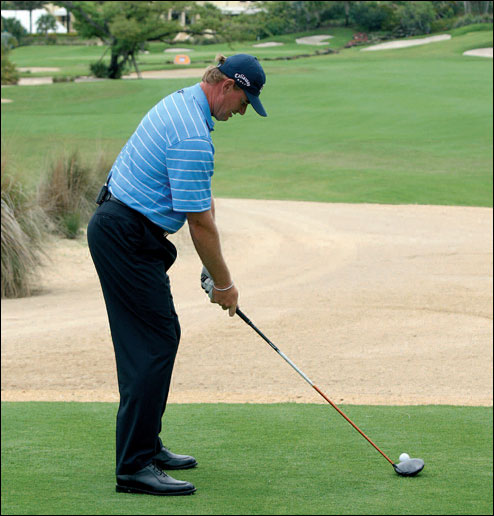
TALL AT THE SET-UP With just a gentle flex in the knees and not too much in the way of angle at the hips, Ernie uses his height to great advantage. He likes to think about standing ‘tall’ over the ball and that’s exactly the impression you get looking at this position – a terrific set-up to copy. The chin is up off the chest while the arms hang comfortably, relaxed. No tension here
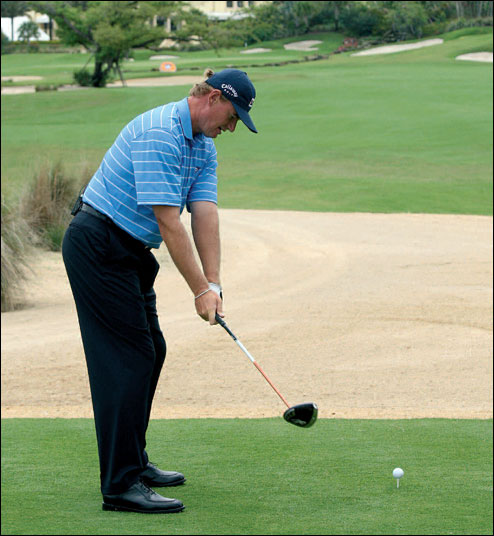
THE MOVEAWAY A sound neutral grip allows Ernie to get the swing started on the natural path. The club here is perfectly on plane. This position is made possible by Ernie’s diligence at the set-up. Notice that the clubhead is still outside the hands – a situation that stays that way until the club is parallel to the ground
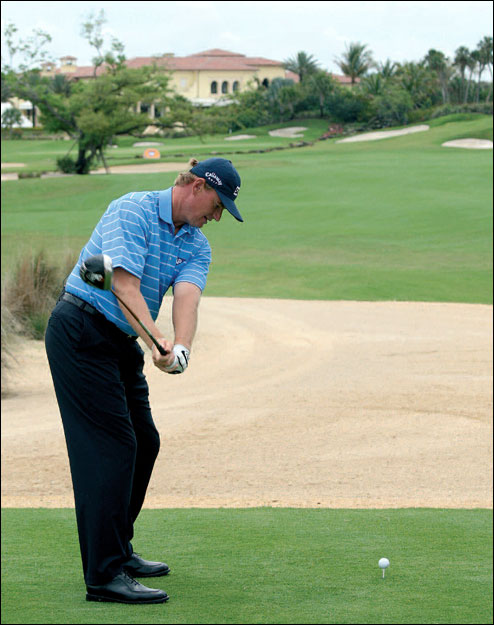
WRIST ‘SET’ Here we can see clearly the way the wrists are gradually hingeing to ‘set’ the club up on plane as the backswing continues. Also, note that the shoulders have turned more than the hips. His shoulders are in control and pulling on his hips as he generates this tremendous ‘coil’. The shaft is right on plane here (main image), running through the right forearm
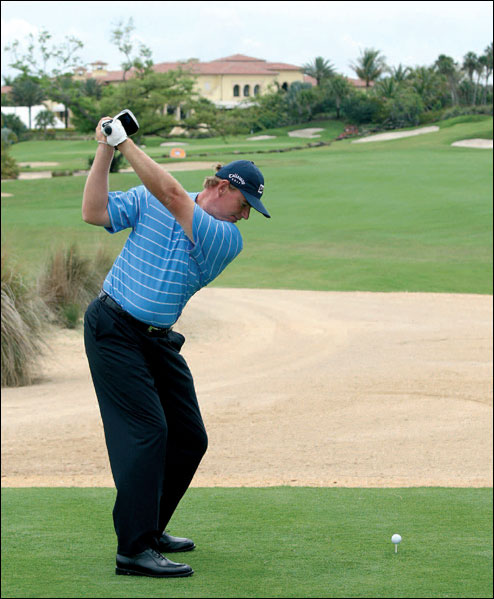
AT THE TOP One of the remarkable aspects of Ernie’s swing is the way he is able to maintain a comfortably straight left arm all the way to the top – a sign of his incredible athleticism and flexibility. Keep in mind there should be no effort to keep it ‘locked’ or straight – that will create tension and cost you power. The club is in a terrific position, balanced between the elbows and parallel with the ball-to-target line
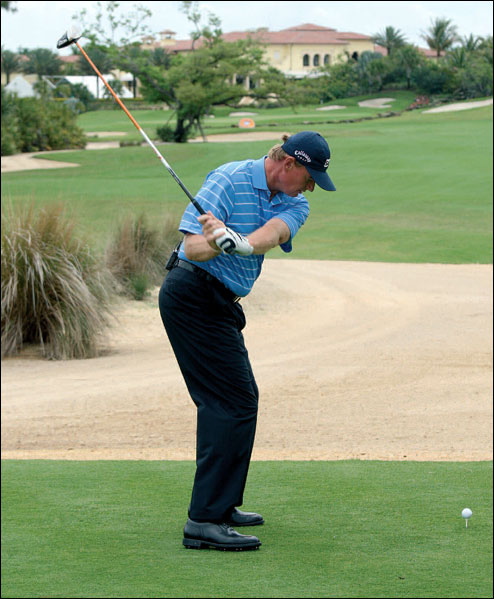
THE TRANSITION Unwinding naturally from the ground up rewards Ernie with this wonderful position on the way down to impact – the knees absorb the slight compression of the body as he prepares to fully unwind the spring and use the centrifugal forces thus generated to accelerate the clubhead into the back of the ball
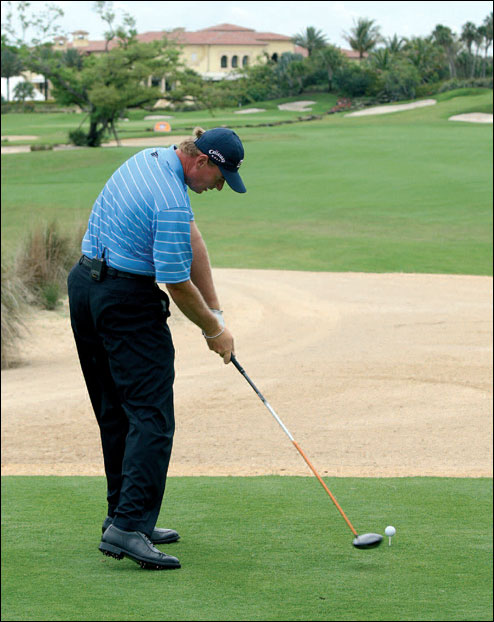
IMPACT Freewheeling into impact, look at how Ernie’s right foot has rolled inward and the heel pulled up off the ground as his left side rotates and clears. We can also see very clearly that the club is approaching the ball from the inside
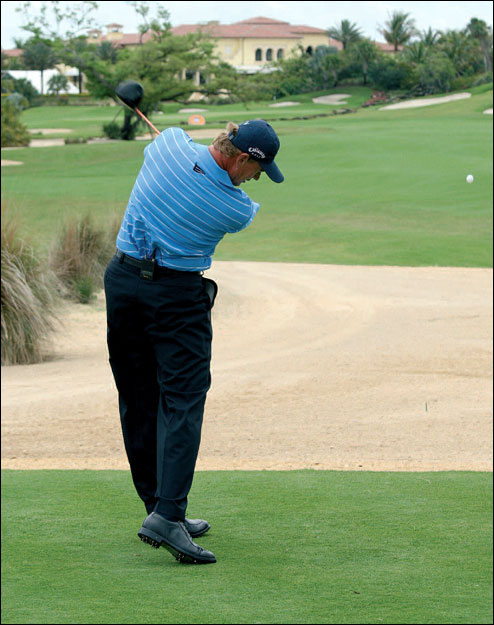
THROUGH THE BALL Having the club shaft ‘exit’ through the left shoulder (looking down the line, as we are here) confirms that Ernie has released the hands and arms correctly, ‘in sync’ with the rotation of his body – and that’s what delivers maximum clubhead speed through the ball
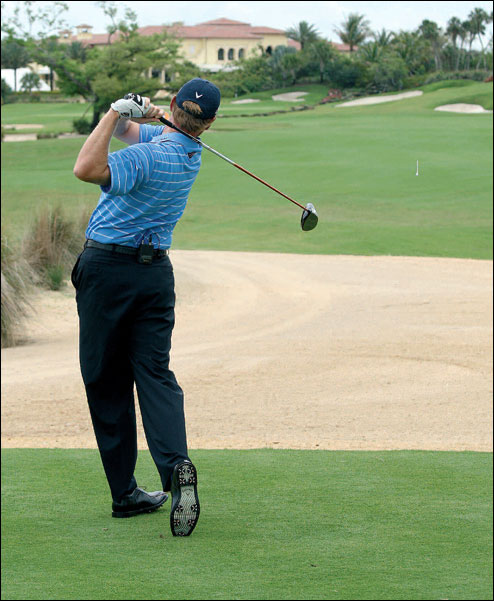
THE FINISH A classic follow-through position, chest and belt buckle turned well to the left of the target, the weight supported on the left side, body supported and balanced on the toe of the right shoe
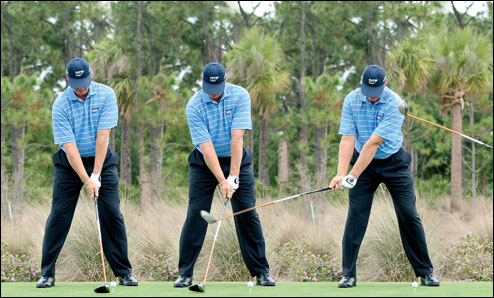
THE SET-UP Picture perfect: Ernie displays a neutral grip, his spine angle is set slightly to the right of the ball (as he looks at it), the ball itself played just inside the left heel. His weight is split approx 60:40 in favour of the right side as Ernie gets himself ready to go. Take note at how relaxed his arms and shoulders are – a textbook lesson for every golfer
THE MOVEAWAY The first move reveals the key to just how in sync Ernie’s swing is from start to finish. Keep in mind that the clubhead has much further to travel than the shoulders and hips. This means it is important that the clubhead travel faster than the other parts in order to reach the top at the same time. The gradual wrist-set that you can see here initiates that proper sequence
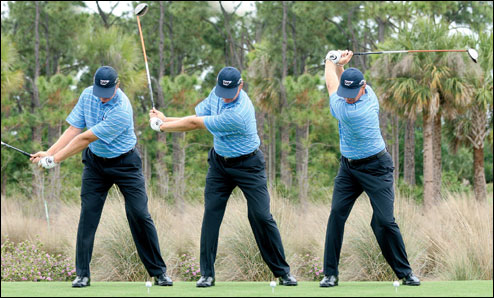
HALFWAY BACK Left arm parallel to the ground, Ernie’s wrists have hinged up to ‘set’ the club at 90 degrees to the left arm, while his shoulders are around 75% turned. From here, all he has to do is complete the turning of the shoulders to reach a solid backswing position.
AT THE TOP So here’s the result of Ernie’s favourite backswing thought: i.e. to ‘turn the left shoulder behind the ball’. A huge shoulder turn is combined with a resisting lower body and a short arm-swing. It’s perfection (and just look at the position of the left arm through these final frames of the backswing – incredible!)
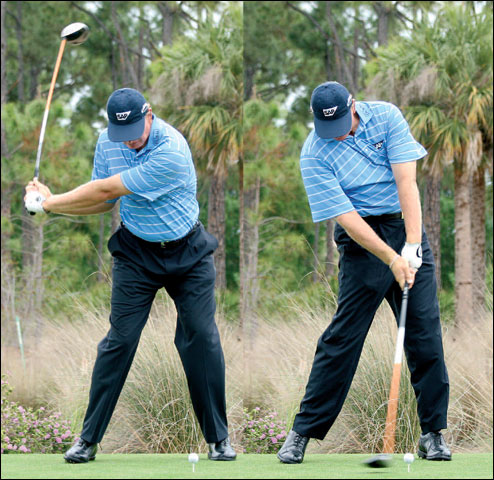
THROUGH THE GEARS Look at the way the left knee has worked from the previous image to this frame. Ernie has initiated his downswing with the lower left side shifting back towards the target and beginning to unwind. His hips are back to square while his upper body remains slightly closed to the target line. With that move he has maximised the coil and torque in his body, and this is what increases the angle in the wrists moving into this hitting position. The motion of the body is Ernie’s secret to effortless speed and power
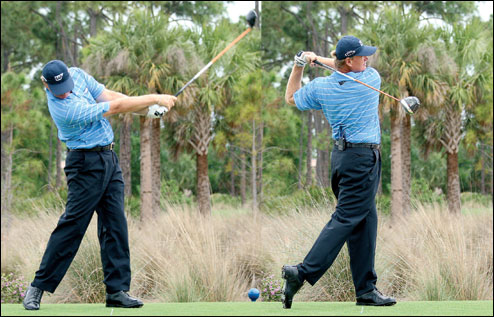
THROUGH THE BALL Through the ball, the full extension that Ernie demonstrates here has been created by the centrifugal force from his body motion, propelling his arms towards the target. If your arms are prone to collapse through the ball, look to your body action for answers, not to your arms and the club
THE FINISH A classic Ernie Els finish – beautiful poise as the arms continue all the way through and around to end up behind the neck, the shaft gently on the back. You can sense, even from this still image, that Ernie has maintained impeccable balance through the swing. He has used the coiling and re-coiling of his body to control the swinging of the arms and the clubhead – and he pulls it off with terrific style
Originally posted in 2009